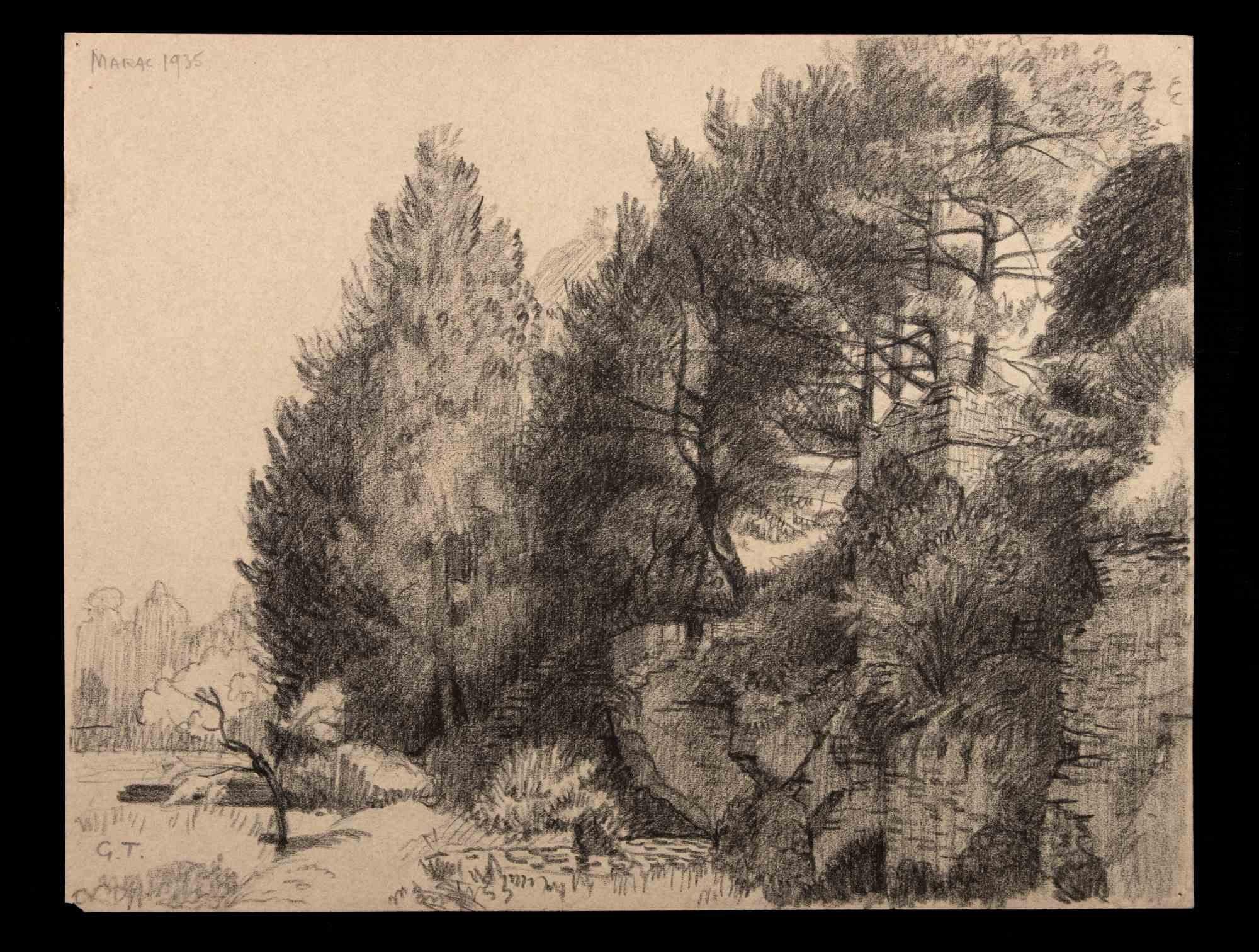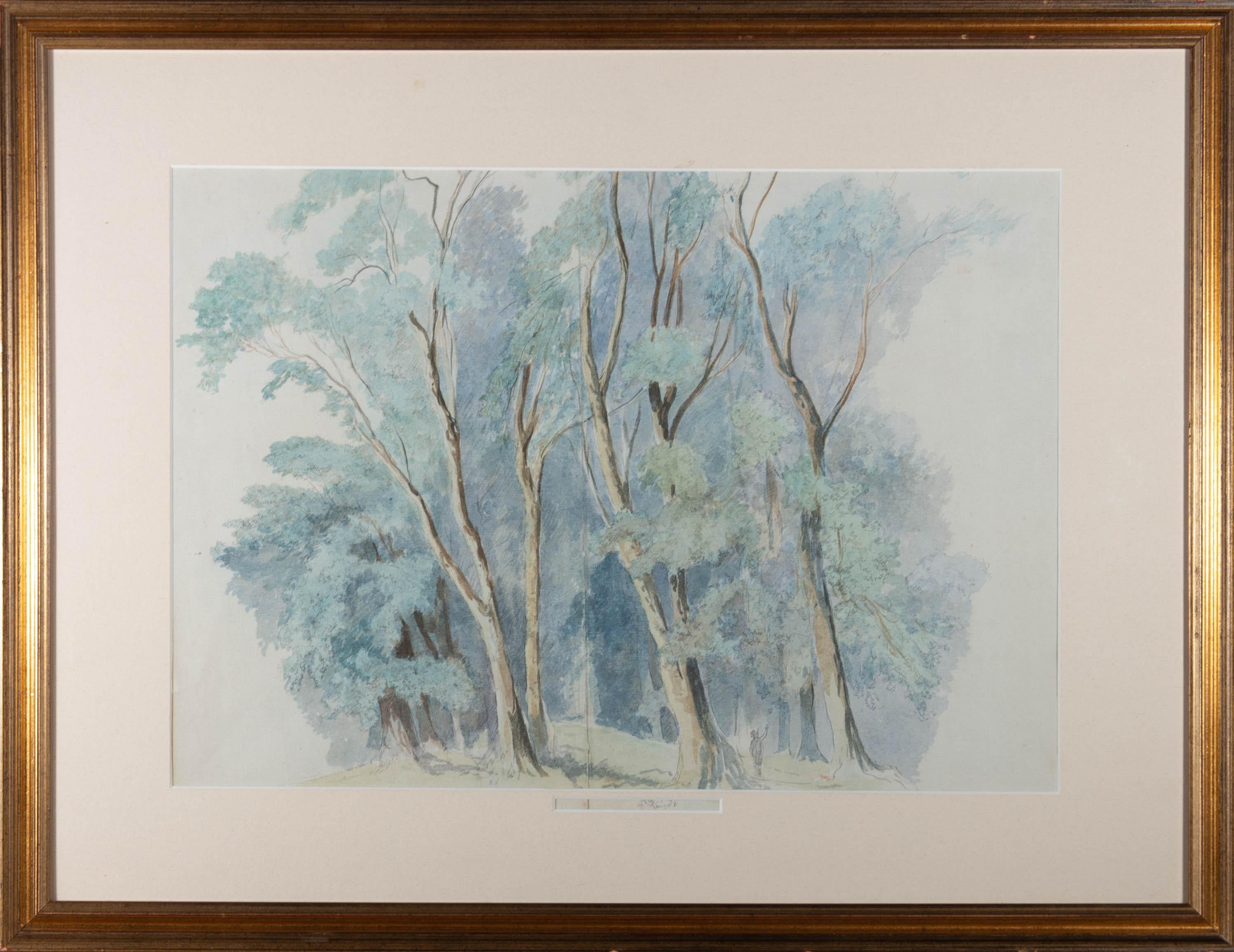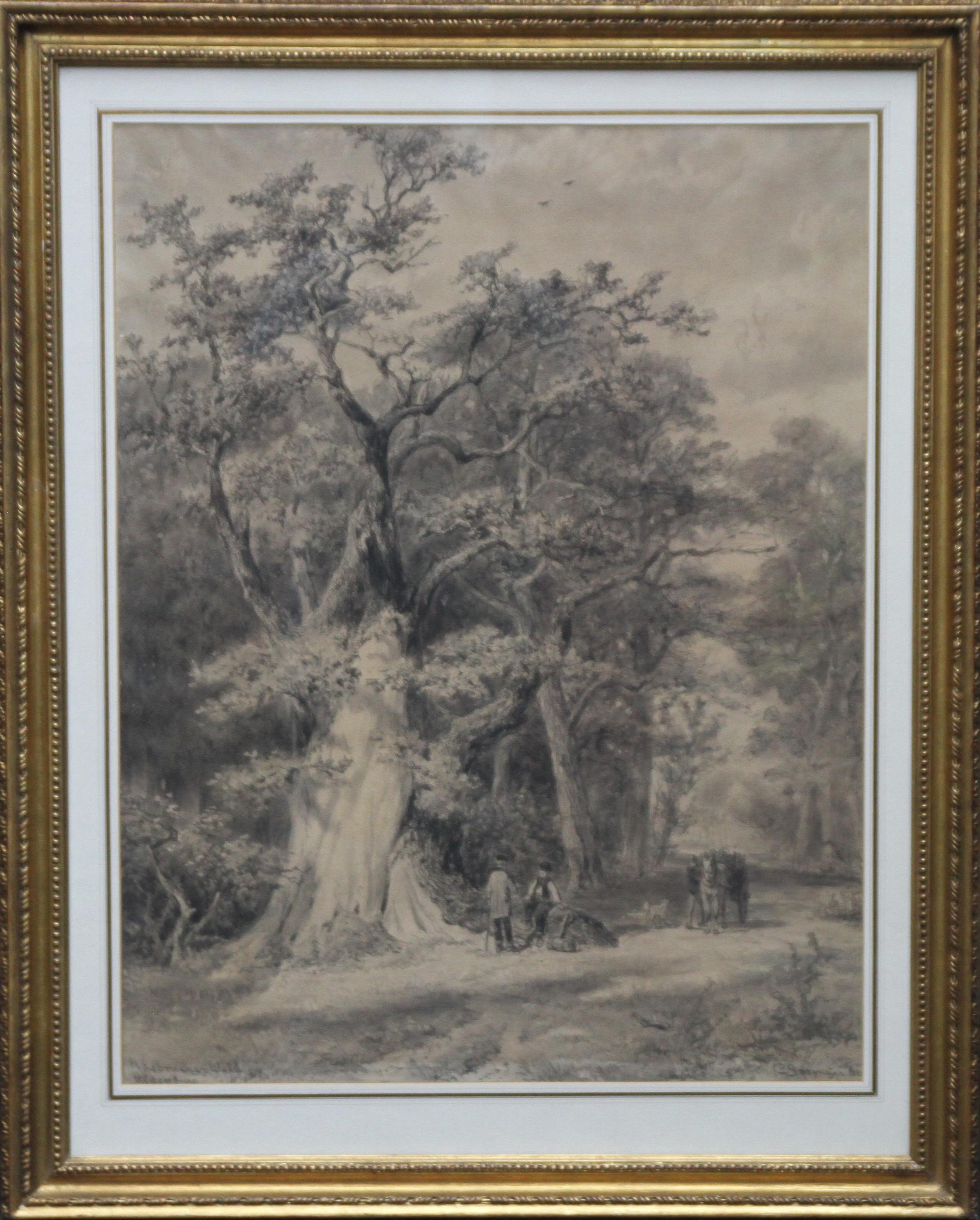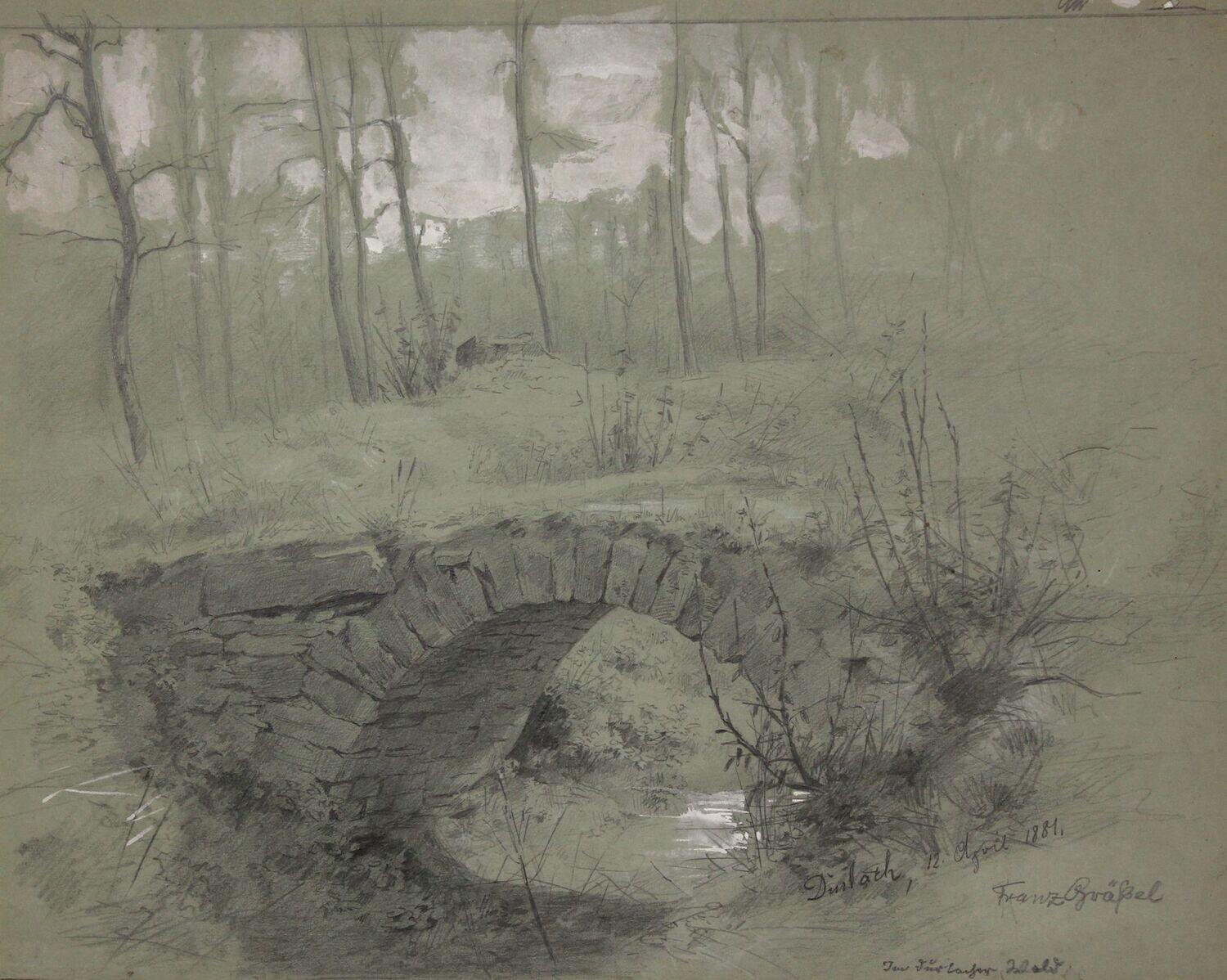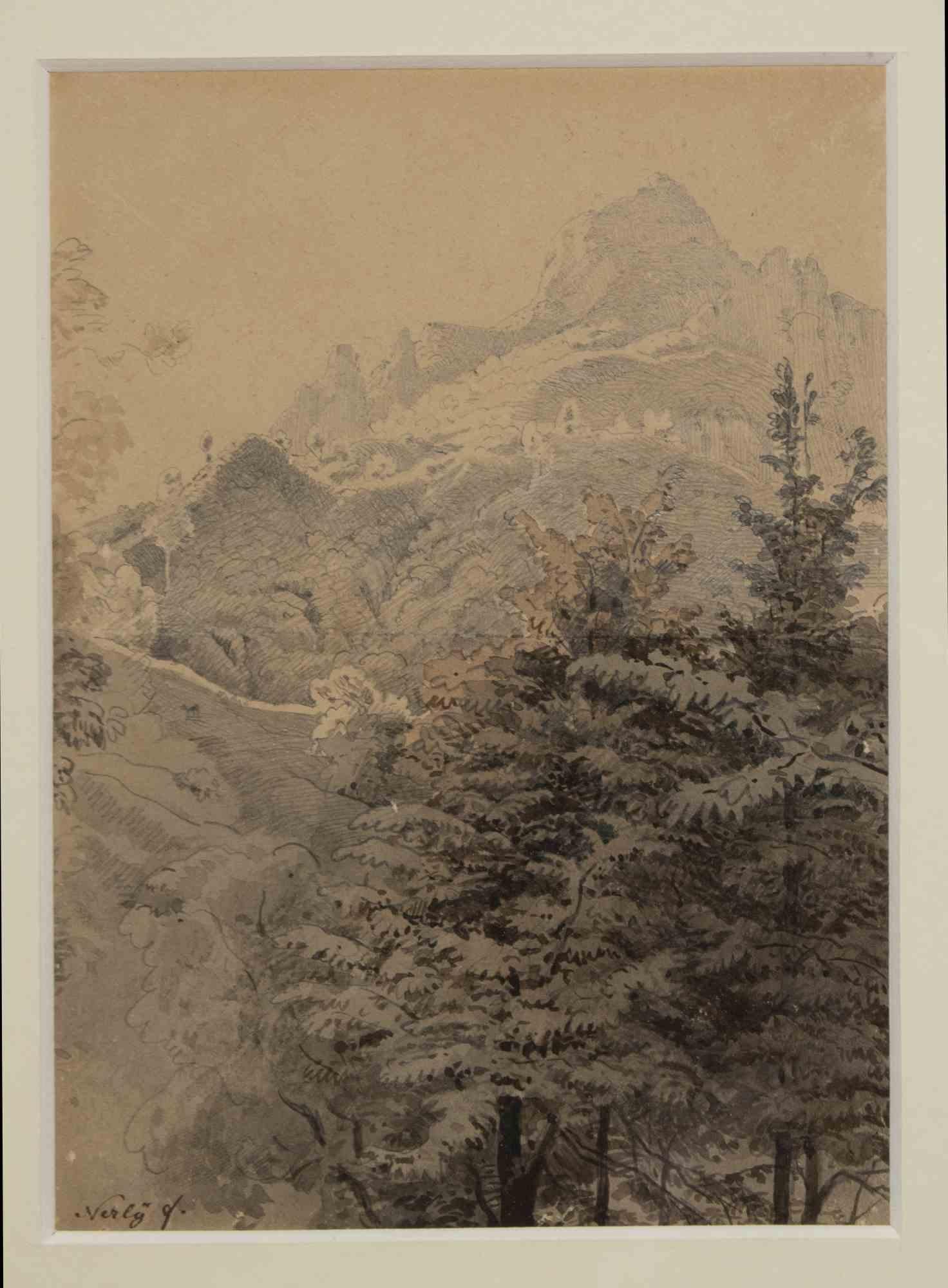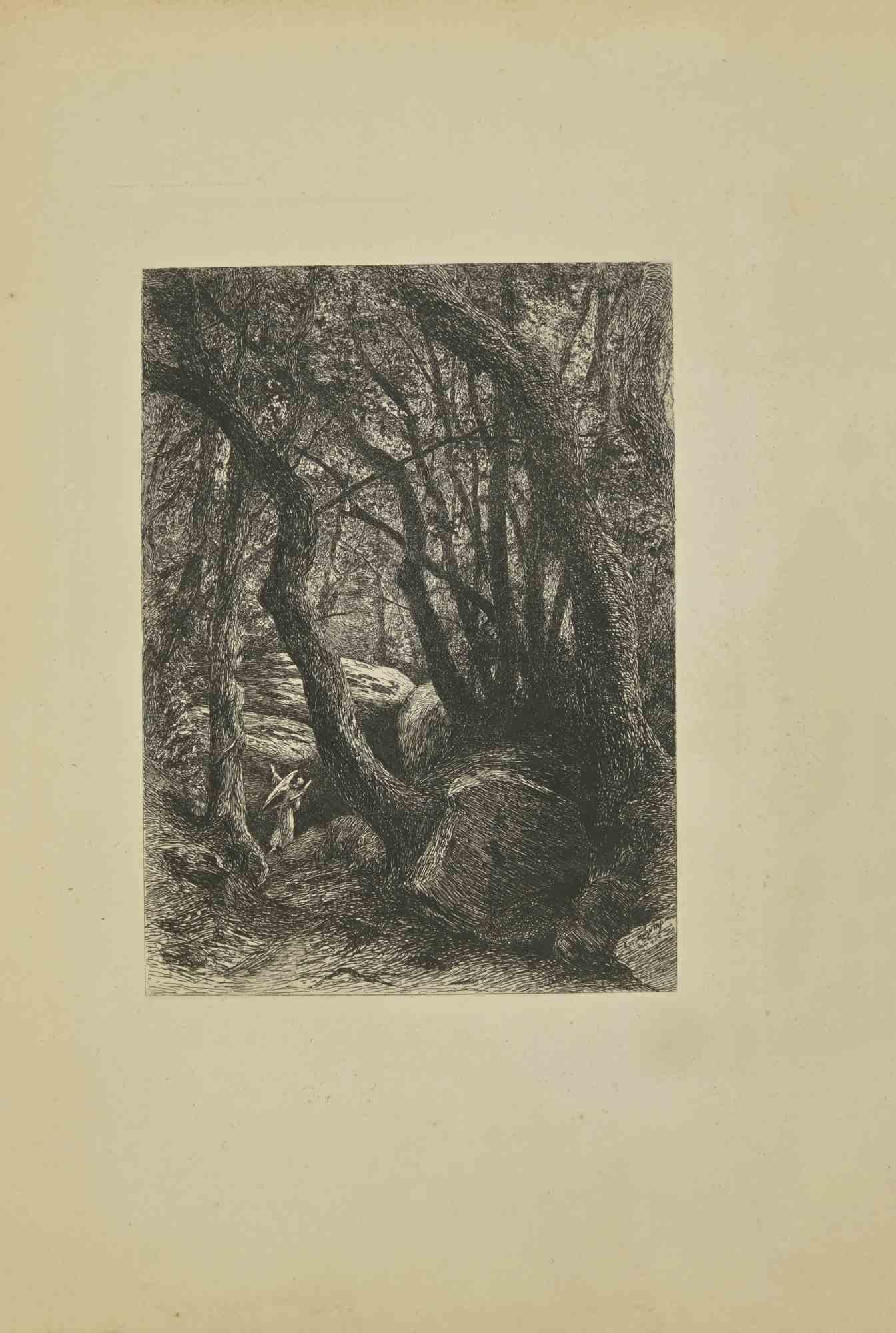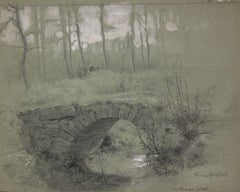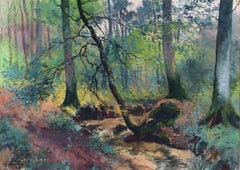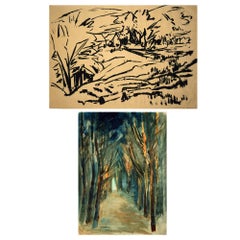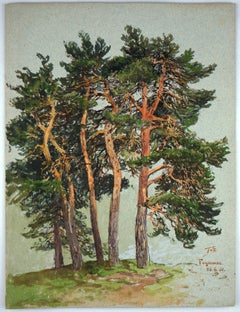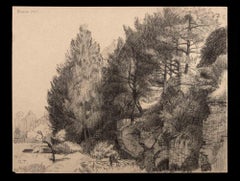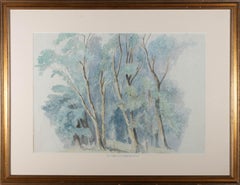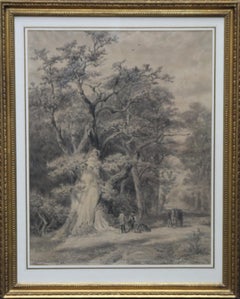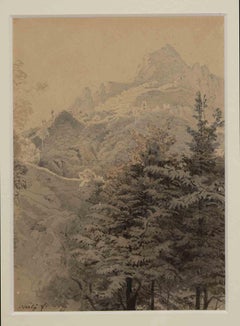Items Similar to Woodland / - The Inner Drama of the Landscape -
Want more images or videos?
Request additional images or videos from the seller
1 of 6
Eduard Peithner von LichtenfelsWoodland / - The Inner Drama of the Landscape -1884
1884
$690.47
£512.78
€580
CA$949.14
A$1,058.04
CHF 556.89
MX$12,826.43
NOK 7,090.19
SEK 6,592.16
DKK 4,415.58
About the Item
Eduard Peithner von Lichtenfels (1833 Vienna - 1913 Berlin), Woodland, 1884. Watercolor and pen and ink on drawing paper, 30.4 cm x 22.5 cm, signed, dated and inscribed by the artist at lower left.
- in good condition
- The Inner Drama of the Landscape -
During his excursions, Eduard Peithner von Lichtenfels repeatedly discovered the inexhaustible richness of nature. Using a combination of pen-and-ink drawing and watercolor, techniques in which the artist specialized, he captured particularly impressive scenes. Here, we see a group of nearly uprooted conifers standing on a slope, extending the terrain's descending line upwards. Their uprooting appears all the more dramatic this way, especially since the two trees standing in a line — viewed from right to left — perform a tilting movement that increases the tension in the picture even more. The movement of the branches, heightened by the interplay of light and shadow, adds to the drama. The location and exact date suggest that this is not an artistic composition but rather an accurate depiction of the inner drama of the natural world before the artist's eyes.
About the artist
Eduard Peithner von Lichtenfels began studying at the Vienna Academy of Fine Arts in 1854. In 1857, he moved to the Düsseldorf Academy of Art, where he was particularly influenced by Carl Friedrich Lessing's landscape paintings. In 1868, he became a member of the Academy in Vienna, where he taught landscape painting as a professor from 1872 to 1907. He also served as rector of the academy from 1878 to 1880 and from 1897 to 1899. As a landscape painting teacher, he promoted close study of nature and regularly took excursions to the Wachau. This led to the Wachau becoming a popular subject in Austrian landscape painting, and some of his students settled there. His students included Ferdinand Andri, Wilhelm Bernatzik, Eduard Zetsche, Heinrich Tomec, Hans Wilt, Johann Nepomuk Geller, and Maximilian Suppantschitsch. After retiring, Peithner von Lichtenfels lived in Nuremberg and Berlin for a time, where he died.
GERMAN VERSION
Eduard Peithner von Lichtenfels (1833 Wien - 1913 Berlin), Waldstück, 1884. Aquarell und Feder auf Zeichenpapier, 30,4 cm x 22,5 cm, links unten eigenhändig signiert, datiert und ortsbezeichnet.
- in gutem Zustand
- Das innere Drama der Landschaft -
Auf seinen Gängen in die Landschaft entdeckte Eduard Peithner von Lichtenfels immer wieder aufs Neue die unerschöpfliche Reichhaltigkeit Natur. Mit der Kombination aus Federzeichnung und Aquarell, auf die sich der Künstler zur Naturdarstellung spezialisiert hatte, hielt er besonders eindrucksvolle Entdeckungen fest. Hier sehen wir eine Gruppe nahezu entwurzelten Nadelbäumen, die an einem Hang stehen und die absteigende Linie des Geländes nach oben verlängern. Auf diese Weise in die Umgebung eingefügt, wirkt ihre Entwurzelung umso dramatischer, zumal die beiden in einer Linie stehenden Bäume – von rechts nach links betrachtet – eine die Bildspannung nochmals steigernde Kippbewegung vollziehen. Dabei entfaltet die durch das Spiel von Licht und Schatten gesteigerte Bewegung der Äste eine zusätzliche dramatische Dynamik. Darauf, dass hier keine künstlerische Komposition vorliegt, sondern der Künstler die innere Dramatik der vor Augen stehenden Natur zur Darstellung gebracht hat, verweist die Ortsbezeichnung und die genaue Datierung.
zum Künstler
Eduard Peithner von Lichtenfels nahm 1854 das Studium an der Wiener Akademie auf und wechselte 1857 an die Düsseldorfer Akademie, wo ihn insbesondere die Landschaftsmalerei Carl Friedrich Lessings prägte. 1868 wurde er Mitglied der Wiener Akademie, an der als Professor von 1872 bis 1907 die Klasse der Landschafsmalerei leitete. Zudem war er von 1878 bis 1880 und von 1897 bis 1899 Rektor der Akademie. Als Lehrer für Landschaftsmalerei beförderte er ein genaues Naturstudium und unternahm regelmäßig Exkursionen in die Wachau, was dazu führte, dass die Wachau in der Folge zu einem bevorzugten Motiv der österreichischen Landschaftsmalerei wurde und sich einige seiner Schüler dort niederließen. Zu seinen Schülern zählten unter anderen Ferdinand Andri, Wilhelm Bernatzik, Eduard Zetsche, Heinrich Tomec, Hans Wilt, Johann Nepomuk Geller und Maximilian Suppantschitsch. Nach seiner Pensionierung lebte Peithner von Lichtenfels zeitweise in Nürnberg und Berlin, wo er verstarb.

About the Seller
5.0
Vetted Professional Seller
Every seller passes strict standards for authenticity and reliability
Established in 2014
1stDibs seller since 2023
21 sales on 1stDibs
- ShippingRetrieving quote...Shipping from: Berlin, Germany
- Return Policy
Authenticity Guarantee
In the unlikely event there’s an issue with an item’s authenticity, contact us within 1 year for a full refund. DetailsMoney-Back Guarantee
If your item is not as described, is damaged in transit, or does not arrive, contact us within 7 days for a full refund. Details24-Hour Cancellation
You have a 24-hour grace period in which to reconsider your purchase, with no questions asked.Vetted Professional Sellers
Our world-class sellers must adhere to strict standards for service and quality, maintaining the integrity of our listings.Price-Match Guarantee
If you find that a seller listed the same item for a lower price elsewhere, we’ll match it.Trusted Global Delivery
Our best-in-class carrier network provides specialized shipping options worldwide, including custom delivery.More From This Seller
View AllIn the forest of Durlach - Quiet ripple in a secret place -
Located in Berlin, DE
Franz Xaver Graessel (1861 Oberasbach/Baden - 1948 Emmering). In the forest of Durlach. 1881. Pencil drawing, heightened with white, on grey-green paper. 33 x 41.7 cm. Signed, dated and inscribed by the artist himself: 'Franz Graessel. Durlach, 12 April 1881".
About the artwork
The drawing depicts a view of the woods which, as if sharpening the visual focus, remains diffuse at the edges and does not allow the viewer to locate himself in the picture. As a result, the landscape appears to be an apparition, but at the same time it is given real substance by the solidity of the massive arched bridge made of quarry stone. As the main motif of the painting, the bridge, which blends in with nature like an archaic relic, also acts as a visual guide, drawing attention to the white, raised waters of the stream and the surrounding vegetation. The diffusion of perception that takes place there, however, draws the eye back to the bridge and thus to the overall view. This movement initiating a constant alternation of diffusion and concretion, which is the specific tension of the painting that brings the landscape to life. The materialisation and dematerialisation, however, does not take place solely through the eye's wandering through the picture; it is simultaneously linked to the viewer's approach to and distance from the picture, which loses its richness of detail precisely in the close-up, only to reconfigure itself with increasing distance.
In this work, which dates from Graessel's studies in Karlsruhe, the artist reflects on the emergence of pictorial objectivity. Here, however, nature is more than a mere motif. The real connection between culture and nature is symbolically expressed by the choice of green paper.
The drawing is an impressive testimony to Graessel's mastery of the sprezzatura with which he skilfully applies the most abstract of strokes, which visibly merge towards the centre of the picture. The signature and the exact date prove that Graessel gave this work more than the character of a mere sketch.
About the artist
Franz Graessel grew up in an environment that was to nourish his later key motifs: his parents' house was a mill. After attending the Karlsruhe Academy of Art from 1878 to 1884, where he studied under Carl Hoff, Graessel continued his training at the Munich Academy from 1886 to 1890 as a pupil of Wilhelm von Lindenschmidt. Trained primarily in genre and portrait painting, he initially portrayed the life of Black Forest farmers. From 1894 he turned increasingly to animal painting, concentrating on the depiction of ducks and geese, which earned him the nickname 'Enten-Graessel'. Graessel's work thus parallels that of Alexander Koester...
Category
1880s Naturalistic Landscape Drawings and Watercolors
Materials
Chalk, Pencil, Paper
$2,285 Sale Price
20% Off
Summer Forest Landscape, 1915 / - The Forest Walk -
Located in Berlin, DE
Stanislas Warnie (1879-1958), Summer Forest Landscape, 1915. Watercolor, 31.5 cm x 45 cm (passepartout), 50.5 cm x 63.5 cm (frame), signed "S. Warnie" at lower left and dated "1915"....
Category
1910s Art Nouveau Landscape Drawings and Watercolors
Materials
Watercolor
$619 Sale Price
20% Off
Landscape verso Forest interior / - Landscape as a space of imagination -
Located in Berlin, DE
Herbert Seidel (1906 Berlin - 1974 Rüdersdorf), Landscape verso Forest interior, around 1950. India ink on grained, bleached paper, 40.5 x 58 cm, signed “Herbert Seidel” in pencil on...
Category
1950s Abstract Landscape Drawings and Watercolors
Materials
Paper
Norwegian Pine Grove - The inner glow of the trees -
Located in Berlin, DE
Themistokles von Eckenbrecher (1842 Athens - 1921 Goslar), Norwegian pine grove, 1901. Watercolor on blue-green paper, 30 x 22 cm. Signed, dated and inscribed in his own hand "TvE. Fagermes [i.e. Fagermes]. 26.6.[19]01."
- Slight crease throughout at left margin, otherwise in good condition.
About the artwork
Themistokles von Eckenbrecher often traveled to Norway to study the nature that fascinated him there. On June 26, 1901, near the southern Norwegian town of Fagernes, in the summer evening sun, he saw a small pine grove, which he immediately captured in a watercolor. He exposed the trees growing on a small hill in front of the background, so that the pines completely define the picture and combine to form a tense motif. The tension comes from the contrast of form and color. The trunks, growing upward, form a vertical structure that is horizontally penetrated by the spreading branches and the pine needles, which are rendered as a plane. This structural tension is further intensified by the color contrast between the brown-reddish iridescent trunks and branches and the green-toned needlework.
Themistokles von Eckenbrecher, however, does not use the observed natural scene as an inspiring model for a dance of color and form that detaches itself from the motif and thus treads the path of abstracting modernism. Its inner vitality is to be brought to light and made aesthetically accessible through the work of art.
It is precisely in order to depict the inner vitality of nature that von Eckenbrecher chooses the technique of watercolor, in which the individual details, such as the needles, are not meticulously worked out, but rather a flowing movement is created that unites the contrasts. The trees seem to have formed the twisted trunks out of their own inner strength as they grew, creatingthose tense lineations that the artist has put into the picture. The inner strength continues in the branches and twigs, culminating in the upward growth of the needles. At the same time, the trunks, illuminated by the setting sun, seem to glow from within, adding an almost dramatic dimension to the growing movement.
Through the artwork, nature itself is revealed as art. In order to make nature visible as art in the work, von Eckenbrecher exposes the group of trees so that they are bounded from the outside by an all-encompassing contour line and merge into an areal unity that enters into a figure-ground relationship with the blue-greenish watercolor paper. The figure-ground relationship emphasizes the ornamental quality of the natural work of art, which further enforces the artwork character of the group of trees.
With the presentation of Themistokles von Eckenbrecher's artistic idea and its realization, it has become clear that the present watercolor is not a study of nature in the sense of a visual note by the artist, which might then be integrated into a larger work context, but a completely independent work of art. This is why von Eckenbrecher signed the watercolor. In addition, it is marked with a place and a date, which confirms that this work of nature presented itself to him in exactly this way at this place at this time. At the same time, the date and place make it clear that the natural work of art has been transferred into the sphere of art and thus removed from the time of the place of nature.
About the artist
Themistocles' parents instilled a life of travel in their son, who is said to have spoken eleven languages. His father, who was interested in ancient and oriental culture, was a doctor and had married Francesca Magdalena Danelon, an Italian, daughter of the British consul in Trieste. During a stay in Athens - Gustav von Eckenbrecher was a friend of Heinrich von Schliemann and is said to have given him crucial clues as to the location of Troy - Themistokles saw the light of day in 1842.
After an interlude in Berlin, where Themistokles was educated at the English-American School, the journey began again. From 1850 to 1857 the family lived in Constantinople, after which the father opened a practice in Potsdam, where Themistokles, who wanted to become a painter, was taught by the court painter Carl Gustav Wegener.
In 1861 the von Eckenbrechers left Potsdam and settled in Düsseldorf. There Themistokles received two years of private tuition from Oswald Aschenbach, who greatly admired the talented young artist. After his artistic training, he undertook extensive travels, often accompanied by Prince Peter zu Sayn-Wittgenstein, which took him to northern and eastern Europe, but above all to the Middle East and even to South America. The paintings that resulted from these journeys established his artistic reputation and led to his participation in large panoramas such as the 118 x 15 metre Entry of the Mecca Caravan into Cairo, painted for the City of Hamburg in 1882.
1882 was also the start of a total of 21 study trips to Scandinavia, most of them to Norway, and the unique Norwegian landscape with its rugged fjords became a central motif in his work. Along with Anders Askevold and Adelsteen Normann...
Category
Early 1900s Naturalistic Landscape Drawings and Watercolors
Materials
Watercolor
$1,142 Sale Price
20% Off
Shady hollow way - Into the heart of the forest -
By Hans Dvoràk
Located in Berlin, DE
Hans Dvořák (19th century). Shady hollow way in a sunny forest. Watercolour and pen-and-ink drawing, 58.5 x 43 cm (visible size), 70 x 55.5 cm (frame), signed and dated "Hans Dvořák ...
Category
1880s Realist Landscape Drawings and Watercolors
Materials
Watercolor
$1,333 Sale Price
20% Off
Forest landscape bathed in sunlight / - The Monumentality of the Forest -
Located in Berlin, DE
Wilhelm Feldmann (1859 Lüneburg - 1932 Lübeck), Sunny forest landscape, c. 1900. Oil on canvas, marouflaged on wood, 37 cm x 48 cm (inside dimensions), 42.5 cm x 53.5 cm (frame), sig...
Category
Early 1900s Impressionist Landscape Paintings
Materials
Oil
You May Also Like
Landscape with Trees - Original Drawing by George-Henri Tribout - 1940
By Georges-Henri Tribout
Located in Roma, IT
Landscape with Trees is an original artwork realized by Georges Henri Tribout in 1935 in Marac. Pencil Drawing, hand signed on the lower margin left and dated "Marac 1935" on the lef...
Category
1940s Modern Landscape Drawings and Watercolors
Materials
Paper, Pencil
Mid 19th Century Watercolour - Forest Seclusion
Located in Corsham, GB
A lively and Romantic watercolour depicting a figure reaching to touch the lower branches of towering trees. Presented glazed in a cream mount and a distressed gilt-effect wooden fra...
Category
19th Century Landscape Drawings and Watercolors
Materials
Watercolor
$296 Sale Price
20% Off
Hasbrucken Wald Altenberg Germany - The Forest - Dutch 19thC wooded landscape
By Cornelius Springer
Located in London, GB
A stunning large drawing, signed and dated 1880, by Cornelius Springer. It is house behind glass in a fine frame. A huge heroic Ruisdael tree empowers this picture. Beneath it, worke...
Category
19th Century Realist Landscape Drawings and Watercolors
Materials
Pencil
Mountains - Original Drawing by Friedrich Paul Nerly - 19th Century
Located in Roma, IT
Mountains is an original artwork realized in the end of 19th century by Friedrich Paul Nerly.
Pencil drawing and watercolor.
The artwork is hand signed on the lower left margin.
T...
Category
Late 19th Century Modern Figurative Drawings and Watercolors
Materials
Watercolor
In The Forest - Etching by Eugène Burnand - Late 19th century
Located in Roma, IT
In The Forest is an etching realized by Eugène Burnand (1850-1921) in the Late 19th century.
Good conditions with foxing.
The artwork is realized through short and deft strokes, a...
Category
Late 19th Century Old Masters Figurative Prints
Materials
Engraving, Etching
Forest - Drawing by Gabriele Galantara - Mid-20th Century
By Gabriele Galantara
Located in Roma, IT
Forest is a modern artwork by Gabriele Galantara (1865-1937) in the early 20th century.
The artwork has been realized in Ink, Charcoal and Watercolor on paper.
Good conditions and ...
Category
Mid-20th Century Modern Figurative Drawings and Watercolors
Materials
Ink, Watercolor, Charcoal
More Ways To Browse
Von Hans
Feder Light
Dating Antique Picture Frames
Antique Hat Tree
Dior Fur Hat
Fur Hat Used
Carl Wilhelms
Maximilian Fur
Contemporary Vintage Photography
Paintings Of Chicago
Paintings Of San Francisco
Gallery Provenance
Large Modern Art Painting
Vintage Publications
Love Acrylic Art
Emotional Paintings
Spiritual Art
Architecture Drawing
